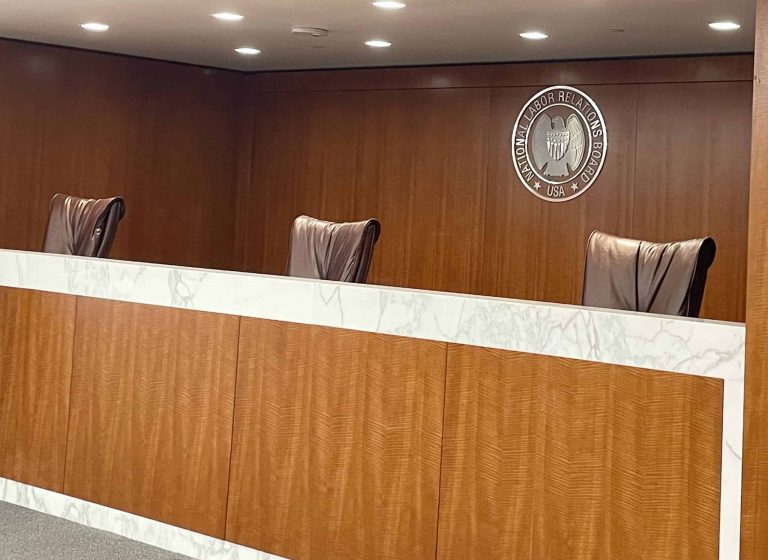Jack Goldsmith is the Learned Hand Professor of Law at Harvard Law School, where he teaches and writes about national security law, international law, internet law, and, recently, labor history. Before coming to Harvard, Professor Goldsmith served as Assistant Attorney General, Office of Legal Counsel from 2003-2004, and Special Counsel to the Department of Defense from 2002-2003.
Trevor Burrus, a Research Fellow at the CATO Institute Center for Constitutional Studies, writes in with this comment on yesterday’s oral argument in Mulhall:
Thank you to Jack for letting me offer my thoughts on Mulhall. As a participant in a moot court with Mulhall’s attorney, William L. Messenger of the National Right to Work Legal Defense Foundation, it was fascinating to hear Bill parry many of the same questions that we asked. Bill, by the way, will also be arguing Harris v. Quinn. Certainly an exciting term for him, for NRTW, and for labor law in general.
This was not an easy case to argue due to the statutory interpretation aspect. The statutory element also makes it a difficult case to count to five on. Let’s see if we can figure it that out.
Section 302 is, at heart, an anti-circumvention statute. As footnote two in government’s brief shows, Section 302’s “thing of value” language is not wildly different than many other statutes that use the term in order to encompass in a variety of corrupting activities. Anti-circumvention provisions exist because those who are trying to get around a legal prohibition—such as the bribery of public officials—are usually more wily than a law’s drafters. As such, interpreting those statutes can often put judges in a bind, choosing whether to enforce a literal reading of “thing of value” or to look more to the overarching purposes of a law.
The arguments on Wednesday morning proceeded generally along those lines. The justices pushed the attorneys to define what is and is not covered by the term “thing of value.” Justice Breyer even invoked the law school 101 hypothetical of “no vehicles in the park,” asking Messenger if organizing agreements such as the one at issue should be given a free pass just like a Jeep used in a war memorial is not considered a vehicle in a park. Messenger strongly and wisely resisted this question by pointing out that Section 302 was specifically amended in 1959 to apply to union organizing. He also correctly argued that wholly exempting organizing agreements would “tear a massive hole” in the statute big enough to, well, drive a Jeep through. On this he is surely correct.
Which brings us to the purpose of Section 302, which I imagine will be where most of the justices’ deliberations will focus. Even though this case largely hinges upon a question of statutory interpretation, there is an ideological undercurrent here, as there usually is when unions are involved.
The NLRA was unquestionably passed in order to make it easier, and more peaceful, for workers to unionize. Resisting workers have always been unions’ biggest problem, and before the NLRA those workers were often given…ahem…let’s just say, very strong reasons to rethink their opposition to the union. If you escaped with just your tires slashed you could consider yourself lucky. Creating a democratic element through which a majority of workers could vote to unionize the entire workforce certainly minimized, but did not eliminate, tire slashing and other coercive acts.
But the NLRA was not just passed to facilitate collective bargaining; it was passed to encourage collective bargaining. In a fundamental sense, the NLRA prefers the rights of the collective over the rights of the dissenting worker. This trade-off, between union “rights” and individual rights, forms the ideological backdrop of this case.
Recently, the balance between union “rights” and individual rights seems to be changing. In Knox v. SEIU (2012), seven justices, including Justices Sotomayor and Ginsburg, voted to give dissenting workers stronger protections against the forced funding of a union’s political speech. Justice Breyer, joined by Justice Kagan, dissented, arguing that the administrative system that gave workers a chance to opt-out of political spending was one “reasonably practical way to permit the principled objector to avoid paying for politics with which he disagrees.” If nothing else, Breyer’s “reasonably practical” standard seems to weigh unions’ rights as nearly equal with dissenting workers’ rights.
In Mulhall, something similar may play out. All the justices are concerned about employers and union bosses colluding with each other to undermine the rights of workers. Some of the justices, seemingly Breyer and Kagan (and to a lesser extent Sotomayor and Ginsburg), will be concerned that a decision defining “thing of value” too broadly will make it too difficult to efficiently and peacefully unionize workers. The NLRB, after all, tends to be pretty inefficient (even when it has a quorum), and agreements such as the one in Mulhall certainly make unionizing easier.
So, can we count to five? Well, that all depends, of course, on how the opinion is drafted. It seems that Justices Sotomayor and Ginsburg would be willing to sign on to an opinion that effectively limited Section 302 to “things of value” that are corrupting. Justice Sotomayor explicitly said she has a “niggling problem” with the “$100,000, because it does feel like a bribe to the employer.” Justice Ginsburg seemed positively disposed toward the Eleventh Circuit’s opinion, which “seemed to agree that these agreements are enforceable. But it said that it can—they can become illegal if used in a scheme to corrupt.”
Although predicting the Court can be a fool’s errand, especially on statutory interpretation questions, I predict a 6-3 victory for Mulhall. The conservatives will use traditional interpretive methods to hold that the statute to encompasses the agreements here, and either Sotomayor or Ginsburg will sign on if they feel the opinion does not make unionizing too difficult. That, or they will concur in result and write a narrower opinion separately.
I’m not, however, putting any bets on this prediction.






Daily News & Commentary
Start your day with our roundup of the latest labor developments. See all
December 22
Worker-friendly legislation enacted in New York; UW Professor wins free speech case; Trucking company ordered to pay $23 million to Teamsters.
December 21
Argentine unions march against labor law reform; WNBA players vote to authorize a strike; and the NLRB prepares to clear its backlog.
December 19
Labor law professors file an amici curiae and the NLRB regains quorum.
December 18
New Jersey adopts disparate impact rules; Teamsters oppose railroad merger; court pauses more shutdown layoffs.
December 17
The TSA suspends a labor union representing 47,000 officers for a second time; the Trump administration seeks to recruit over 1,000 artificial intelligence experts to the federal workforce; and the New York Times reports on the tumultuous changes that U.S. labor relations has seen over the past year.
December 16
Second Circuit affirms dismissal of former collegiate athletes’ antitrust suit; UPS will invest $120 million in truck-unloading robots; Sharon Block argues there are reasons for optimism about labor’s future.